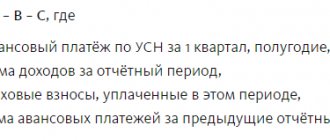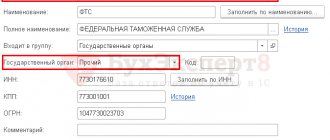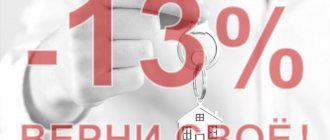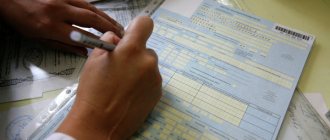The VAT calculator performs tax calculations online. The calculator will help you allocate or charge VAT. The results are displayed in both numbers and words.
You can change the VAT rate, copy and save the final calculations in the calculator's memory.
| Add to bookmarks |
Hide numbers in words
Instructions for using the VAT Calculator
We recommend that you first select “Calculation Type” (Select or Calculate VAT) since the calculator shows all calculations immediately as you enter the numbers. The operating mode can be changed by clicking on the corresponding button or clicking on the name of the operating mode. If necessary, change the VAT rate.
All calculations on the VAT calculator can be made even if there is no Internet connection. The last entered “Operating mode” and “VAT rate” are saved in the calculator’s memory. To copy “VAT Amount” or “Amount Without/With VAT”, click on the numbers and a special window will appear. When you press the “X” button, the calculator is reset to its original settings (VAT allocation at a rate of 20%).
The calculation results are displayed both numerically and in words. It is convenient to copy amounts in words from special fields.
The calculation results can be saved using the “Save” button. The table of saved results can be edited by deleting unnecessary calculations. By clicking on a row in the table of saved results, you can transfer the data to the main calculations.
By copying the “Link to the result”, you can send a link to the calculations made by e-mail or messenger.
VAT calculation formula
To isolate VAT from the amount, you need to multiply the Price with VAT by 20 and divide by 120. Let's try to calculate the VAT, separate the VAT from 550: 550x18/120 = 83.90. VAT is 83.90, the amount without VAT is 550-83.90 = 466.10.
Calculating VAT is also not difficult. It is necessary to multiply the Price without VAT by 0.20 (we get the VAT amount) and add the Price without VAT to the resulting result. For example, let's charge VAT on 550: 550x0.20+550=649. VAT is 99.00, the amount including VAT is 649.00..
From the history of VAT
In Russia, VAT (Value Added Tax) was first introduced in 1992. Initially, the rules and procedure for calculating VAT were regulated by a separate law “On Value Added Tax”; later VAT became regulated by Chapter 21 of the Tax Code. Initially, the VAT rate reached 28%, but was later reduced to 20%. Currently, the main VAT rate in force in Russia is 20%. A reduced VAT rate of 10% applies to medical and children's goods, printed publications, and book products.
The VAT calculator is the simplest and instant way to calculate the amount of tax payable. If you do not know how to correctly calculate value added tax, use our service. A novice entrepreneur or inexperienced accountant does not need to delve into the intricacies of mathematical calculations. It is enough to enter the amount of income from which to withhold, or the amount to which tax must be added.
Result:
Should VAT be calculated directly or reversely in the invoice?
A question has arisen regarding the algorithm for calculating VAT in printed forms TORG-12 and Invoices in 1C Enterprise. Let me explain the essence of the problem (prices in 1C are stored including VAT, sales documents are issued with VAT in the amount), when displaying a printed form on the screen, the procedure for calculating VAT is as follows: 1. The amount of the document line is taken. 2. The VAT rate is “subtracted” from this amount, i.e. We receive the amount without VAT. 3. Next, this amount is divided by the quantity, and we get the price excluding VAT. Naturally, with this (“reverse”) procedure for calculating VAT, Price Without VAT * Quantity <> Amount Without VAT. Let me explain with an example: 10 units of goods were sold at a price of 323.10, respectively, the amount including taxes is 3,231.00. VAT rate is 18%. The VAT amount is 492.86. The amount excluding VAT is 2'738.14. Price — 273.81 rub. So we get that 273.81 * 10 = 2'738.10, but not 2'738.14. What customers complain about and do not want to accept the product. Like, they say your price * quantity does not equal the amount. Especially for them, I rewrote the invoice, bidding-12 and invoice (printed forms) so that the price without VAT was calculated first, and then everything else. Those. First, we calculate the price without VAT - 273.81, then multiply it by the quantity (10), we get the amount without VAT - 2'738.10. VAT = Amount - Amount Without VAT = 3'231.00 - 2'738.10 = 492.90. But this is only in printed form; naturally, in 1C, the sales document contains the amount of VAT - 492.86. Question: How legal are clients’ demands to present TORG-12 and an invoice only using the direct procedure for calculating VAT? They focus on clause 5 of Article 169 of the Tax Code of the Russian Federation and draw our attention, I quote, “Please note that the primary documents of the Tax Code, TTN, as well as invoices filled out in violation of the specified procedure, incl. using the “reverse” method of calculating VAT will not be accepted for accounting and must be replaced.” Do they have the right to refuse to accept documents where the VAT amount is calculated in reverse? If their actions are unauthorized, then what should we refer to (Article of the Tax Code or something else) to explain to them that they are obliged to accept documents drawn up in this way?
VAT refund
We can talk about a refund only if, at the end of the tax period, the amount of VAT deductions is greater than the amount of tax accrued for payment to the budget for the same period. The picture is reflected in the VAT return; the return rules for legal entities and individual entrepreneurs are no different.
There are two main points that the person preparing the declaration should have:
- right to refund of tax deductions;
- VAT payer status.
Typically, those who work on the general tax system have VAT payer status. They are required to charge VAT on all transactions that are subject to VAT. Their responsibilities also include submitting declarations, issuing invoices and maintaining a ledger of sales and purchases.
They also have the right to apply deductions in the amount of tax that is presented by suppliers and arises in certain other transactions.
In some cases, defaulters may also be required to pay VAT. But they will not have the right to deduction.
At the same time, a VAT refund implies a series of actions, after which the amount of tax from the budget will be returned to the entrepreneur’s bank account.
A similar situation is faced by exporters who apply a zero rate on goods shipped for export and who are entitled to a tax deduction. The latter is calculated from the amount transferred to suppliers for the purchase of goods, works and services that relate to sales abroad.
Depending on what share of export sales occurs in the total sales volume, the need for a VAT refund may arise each reporting period.
It should be noted that the excess of the amount of deductions over the amount of accrued VAT is not a guarantee of a refund. To return, you must follow the established procedure. The key point in it is the desk audit, which is carried out after filing the declaration.
To do this, a voluminous package of documents is requested, which are divided into two groups:
- confirming the right to apply the zero rate;
- justification for the deduction amount.
The role of value added tax in the Russian Federation
Value added tax is an indirect tax of federal significance and plays a significant role in the formation of the budget of the Russian Federation. The value added tax is regulated by Chapter 21 Part 2 of the Tax Code of the Russian Federation.
The role of VAT in the state is quite high. Currently, the entire tax amount goes to the Federal Budget, which makes it possible to solve such important government tasks as:
- repayment of public debt;
- increasing pension and social benefits to citizens of the Russian Federation;
- implementation of a number of federal social programs, etc.
| ★ Best-selling book “Accounting from scratch” for dummies (understand how to do accounting in 72 hours) > 8,000 books purchased |
Types of bets
Sometimes it is necessary to know what VAT rates apply.
There are three main VAT rates in the legislation of the Russian Federation:
- Zero. There is a list of goods approved by the Tax Code on which VAT is not charged. This happens in the case of their export with further sale.
- 10% - used for a special type of product that is considered necessary in terms of life support, such as milk, bread, cereals, medicines, and so on. This list can be expanded in the event of a crisis.
- 20% is the most common rate. All other goods and services are taxed according to it. Until 2021 it was 18%.
Algorithm of actions when calculating VAT
In order to accurately calculate VAT, you need to determine the following criteria:
| Criteria | Explanation |
| Determine tax rate | In accordance with Article 164 of the Tax Code of the Russian Federation, the following tax rates have been adopted:
|
| Determine the tax base | Initial cost of production + excise taxes |
| Calculate VAT using a specific formula | Formulas are presented in the section “Rate, formulas used for calculation” of this article |
In reality, there is nothing difficult in calculating VAT. It is enough to have specific ideas about the tax rate and tax base.
Rate, formulas used for calculation
In accordance with Article 163 of the Tax Code of the Russian Federation, the VAT tax rate will depend on the economic activity carried out by the organization:
| VAT rate | Economic activity |
| 0% | Sales within the customs zone, export of products, international transportation. |
| 10% | Sale of children's products, medical supplies, some food products, printed publications, breeding animals and birds. |
| 18% | All business activities not mentioned above. |
It is very important to correctly determine the tax rate in order to avoid problems with the tax authorities.
Entrepreneurs have to deal with two cases of VAT calculation:
- it is necessary to determine VAT on the cost of goods, works, services;
- it is necessary to allocate VAT from the existing total amount.
If VAT is required on the cost of goods, works, services, the following formulas are used:
- VAT 18%:
| VAT | = | total amount | * | 0,18 |
- VAT 10%:
| VAT | = | total amount | * | 0,10 |
For example:
ABV LLC sells products to individual entrepreneur M.M. Mokhov. in the amount of 70,000 rubles. VAT 18%. The VAT amount will be 70,000 * 0.18 = 12,600 rubles. The amount to be paid will be 70,000 + 12,600 = 82,600 rubles.
Total:
The cost of production is 70,000 rubles. VAT 18% – 12,600 rubles. Payable – 82,600 rubles.
If it is necessary to isolate VAT from an existing total amount, the following formulas are recommended for use:
- allocation of VAT 18%:
| VAT | = | total amount | / | 118 | * | 18 |
- allocation of VAT 10%:
| VAT | = | total amount | / | 110 | * | 10 |
- 0% VAT is not allocated.
For example:
ABC LLC sells fishing nets at a price of 600 rubles per piece. including VAT 18%. IP Mokhov M.M. ordered 25 pcs. First you need to determine the total amount: 600 * 25 = 15,000 rubles. VAT will be: 15,000 / 118 * 18 = 2,288 rubles. Amount without VAT: 15,000 – 2,288 = 12,712 rubles.
Total:
The amount excluding VAT is 12,712 rubles. VAT 18% – 2288 rubles. The total amount to be paid is 15,000 rubles.
What do you need to know to calculate VAT?
To calculate VAT, entrepreneurs need to decide on the indicators used to carry out this calculation:
| Index | |
| The tax base | The tax base for calculating VAT will be considered (Article 153 of the Tax Code of the Russian Federation): · the volume of proceeds received from the sale of goods, services, works, property rights; · the amount of proceeds received under the agency agreement; · volume of funds received from the sale of imported goods, etc. |
| Tax rate | The tax rate is determined by Article 164 of the Tax Code of the Russian Federation and can be equal to 0%, 10%, 18%. |
Accrual methods
Today there are two main ways to calculate VAT:
- Subtraction. The amount of revenue is taxed, after which the amount of VAT spent on the purchase of materials is subtracted from it.
- Addition. The tax is calculated at the rate of the entire tax base, consisting of the added value of the products sold.
Most entrepreneurs choose the first method of accounting, since the second can be difficult due to the need to separately calculate each product sold.
How to determine the appropriate rate?
To determine the tax rate, you must be guided by Article 164 of the Tax Code of the Russian Federation:
| Tax rate | Type of economic activity |
| 0% | · export of goods; · international transportation of goods; · work related to pipeline transport of oil and petroleum products; · organization of pipeline transportation of natural gas; · export of electricity; · transshipment and storage of export goods in sea and river ports; · services for processing goods in customs zones; · goods, works, services in the field of space activities; · rail transportation of passengers and luggage on commuter and long-distance trains; · extraction of precious metals from scrap and waste; · goods, works, services for foreign diplomats. |
| 10% | · sales of food products; · sales of children's goods; · sales of printed products; · sale of medical products; · domestic air transportation. |
| 18% | All other cases not mentioned earlier. |
As is already clear, the tax rate depends on the type of economic activity. There are situations when an organization can simultaneously perform several operations related to different tax rates. In this case, it is necessary to make calculations very carefully using VAT calculation formulas.
How to calculate VAT including
Calculating VAT as well means highlighting the tax that is included in the final amount. Here the formulas are used for calculation:
VAT = C / 120 × 20 - if you need to calculate VAT 20% (from 01/01/2019),
VAT = C / 118 × 18 - if you need to calculate VAT 18% (until 01/01/2019),
VAT = C / 110 × 10 - if the tax rate is 10%,
Where: C is the amount including VAT.
ATTENTION! This calculation does not mean applying estimated rates of 20/120 (18/118) or 10/110 - it is simply a way to separate the tax from the total.
Read more about settlement rates in this article .
How to calculate VAT on the amount?
There are situations when payment documents and contracts do not contain the VAT amount:
- advance payment against future delivery of goods;
- carrying out tax calculations by a tax agent;
- VAT is included in the price of the goods, but is not allocated.
In these cases, it is necessary to allocate VAT using the following formula (depending on the tax rate):
- allocation of VAT 18%:
| VAT | = | total amount | / | 118 | * | 18 |
- allocation of VAT 10%:
| VAT | = | total amount | / | 110 | * | 10 |
Calculation of tax included in the price
In some cases, for example, when the goods were purchased and shipped or work was carried out earlier, VAT may already be included in the price. Then you need to calculate it differently.
This usually happens in the following cases:
- when making advance payments for future delivery of goods/services or work provided;
- if the contract indicates the cost, provided that VAT is already included in it, but its amount has not been calculated.
In this case, there are two formulas for calculating VAT:
- multiplying the transaction value with tax by 20 and dividing by 120;
- multiplying the tax value by 0.2 and dividing by 1.2.
Another way is to take 16.6666...% of the amount, the resulting number is rounded to the nearest kopeck. Based on this calculation formula, you can understand how to calculate the amount excluding VAT.
How to calculate VAT for a quarter/half year/year?
The tax period for paying VAT is a quarter (Article 163 of the Tax Code of the Russian Federation). The declaration must be submitted to the tax authorities within the following deadlines:
| Quarter | Deadline for submitting the declaration |
| 1st quarter | Until April 25 |
| 2nd quarter | Until July 25 |
| 3rd quarter | Until October 25 |
| 4th quarter | Until January 25 |
VAT is paid in equal installments before the 20th day of each month of the next quarter:
| Quarter | VAT payment deadlines |
| 1st quarter | Until April 25, until May 25, until June 25 |
| 2nd quarter | Until July 25, until August 25, until September 25 |
| 3rd quarter | Until October 25, until November 25, until December 25 |
| 4th quarter | Until January 25, until February 25, until March 25 |
To correctly calculate VAT for the quarter, you must:
- Determine the tax base - the sum of all income received by the taxpayer during the tax period (Article 153 of the Tax Code of the Russian Federation):
| The tax base | = | Income received from sales | + | Advances |
- After determining the tax base, it is necessary to calculate VAT:
| VAT | = | The tax base | * | 0,18 (0,10) |
If an organization was engaged in the sale of goods, works, or services subject to different VAT tax rates, it is necessary to make calculations separately for each category.
Return scheme
The VAT refund scheme for dummies can be presented as step-by-step instructions:
- Step 1. Submitting a declaration with the amount of VAT to be refunded. A desk audit of such a declaration is carried out within 2 months, in some cases - 3. During the audit, tax authorities may require documents that confirm the use of tax deductions. If there are violations, go to step 2, if not, go straight to step 6.
- Step 2. Drawing up a tax audit report for violations.
- Step 3. Submission of written objections by the taxpayer. Done within a month from the date of issuance of the tax audit report. If the entrepreneur does not agree with the result, it is necessary to provide a written objection indicating the reason.
- Step 4. Deciding whether or not to hold the taxpayer accountable. Occurs within 10 days after receiving objections. The tax office makes a decision on VAT refund or refusal of such refund. Before making a decision, the tax authority checks the presence of arrears on the tax and all other taxes and payments related to federal ones. If there is arrears, then go to step 5, if not, go to step 7.
- Step 5. The VAT refund is reduced by the amount necessary to pay off the debt on federal taxes, VAT penalties or other taxes and penalties.
- Step 6. Making a decision on VAT refund if there are no violations during the desk audit. The tax service is given 7 working days for this.
- Step 7. VAT refund to the taxpayer in the absence of arrears. This happens by transferring the amount to a bank account within 5 working days from the receipt of the refund notification.
VAT innovations in 2021
There are no global changes in relation to VAT in 2021, but a number of innovations are still worth noting:
| Innovation | Explanation | Normative act |
| VAT 15.25% for foreign companies providing Internet services | This innovation will apply to almost all electronic service providers not registered in the Russian Federation. | Federal Law of July 3, 2016 No. 244-FZ |
| VAT 10% for publications with advertising volume no more than 45% | Previously, advertising volume was limited to 40%. | Federal Law of November 30, 2016 No. 408-FZ |
| Even more transactions are subject to 10% VAT. | Operations related to the issuance of guarantees and guarantees to non-banking organizations. | Federal Law of November 30, 2016 No. 408-FZ |
When is VAT charged and when is it not?
VAT is charged on the following types of transactions:
- Import of goods.
- Operations related to the construction of buildings.
- Transfer of services and products for your own use.
Transactions that are not subject to this tax:
- provision of services by public authorities;
- purchase or privatization of state-owned enterprises;
- investments;
- sale of land plots;
- lending money to organizations on a non-profit basis.
A VAT return must be submitted along with the payment.
VAT calculation errors
Incorrect calculation of VAT entails the imposition of penalties on the organization. But often erroneous calculations still occur:
| Error | |
| Advance payments are not included in the tax base | In accordance with Article 154 of the Tax Code of the Russian Federation, advance payments are subject to VAT calculation. |
| Accepted for accounting for input VAT in case of an incorrectly drawn up invoice | This error may cause suspicion and mistrust of the tax authorities. Incoming invoices must be closely monitored. |
| There is no separate accounting | If an organization refuses to keep separate records of transactions subject to VAT and non-VAT, VAT will not be deductible. |
| VAT refund for fines or penalties | A fine or penalty is not considered to be goods, work, or services, and therefore VAT refunds cannot be made. |
History of origin
The tax was originally developed and adopted in France at the beginning of the twentieth century. It did not take root due to a large number of inaccuracies and consisted of a tax on the sale of goods.
Closer to the 50s, a new, more complex system was developed that determined the payment and reimbursement of VAT in the Tax Code. It was somewhat similar to what exists today.
In Russia, VAT was introduced in 1992. Although this was not possible the first time, since at that moment the economic and political situation in the country was quite difficult.
Questions and answers
Question No. 1. Our company has purchased goods for subsequent sale, but has not yet been sold. Should we take VAT into account?
Answer: Of course they should. Input VAT is then used as a deduction.
Question No. 2. We plan to use cargo transportation services. Can we deduct VAT in the future?
Answer: If you have an invoice, you can count on the right to deduct VAT.
Question No. 3. The organization shipped the goods, but did not receive payment. When is VAT required?
Answer: VAT must be calculated immediately as soon as the goods are disposed of, i.e. from the moment of shipment.
Question No. 4. HOA "Trudovik" carries out maintenance of its home on its own. What is subject to VAT calculation in this case?
Answer: In this case, VAT is not subject to payment for accommodation in the apartment. And payments for all services (cleaning of the territory, security, utilities) are subject to VAT.
Payment deadline for special modes
If an organization or individual entrepreneur is in a special regime and is exempt from paying VAT, situations may still arise when you still have to pay tax.
These include:
- Import of goods from the EAEU countries - no later than the 20th of the next month.
- Acting as a tax agent - when purchasing works from a foreign company on the day the money is transferred, in all other cases - according to the general rules.
- When issuing an invoice with the specified VAT amount - no later than the 25th day of the month following the quarter when such an invoice was issued.
This information may not always be sufficient for people who understand this issue. But here is everything you need to know about VAT for beginners.
Online VAT calculator
Instructions for using the VAT Calculator
We recommend that you first select “Calculation Type” (Select or Calculate VAT) since the calculator shows all calculations immediately as you enter the numbers. The operating mode can be changed by clicking on the corresponding button or clicking on the name of the operating mode. If necessary, change the VAT rate.
All calculations on the VAT calculator can be made even if there is no Internet connection. The last entered “Operating mode” and “VAT rate” are saved in the calculator’s memory. To copy the “VAT Amount” or “Amount Without/With VAT”, click on the numbers and a special window will appear. When you press the “X” button, the calculator is reset to its original settings (VAT allocation at a rate of 20%).
The calculation results are displayed both numerically and in words. It is convenient to copy amounts in words from special fields.
The calculation results can be saved using the “Save” button. The table of saved results can be edited by deleting unnecessary calculations. By clicking on a row in the table of saved results, you can transfer the data to the main calculations.
By copying the “Link to the result”, you can send a link to the calculations made by e-mail or messenger.
VAT calculation formula
Calculating VAT is also not difficult. It is necessary to multiply the Price without VAT by 0.20 (we get the VAT amount) and add the Price without VAT to the resulting result. For example, let's charge VAT on 550: 550x0.20+550=649. VAT is 99.00, the amount including VAT is 649.00..
From the history of VAT
In Russia, VAT (Value Added Tax) was first introduced in 1992. Initially, the rules and procedure for calculating VAT were regulated by a separate law “On Value Added Tax”; later VAT became regulated by Chapter 21 of the Tax Code. Initially, the VAT rate reached 28%, but was later reduced to 20%. Currently, the main VAT rate in force in Russia is 20%. A reduced VAT rate of 10% applies to medical and children's goods, printed publications, and book products.
Please note, the VAT rate has changed from 18 to 20%. You will find the formula for calculating VAT 20 percent in a new article at the link: how to calculate VAT 20%
Value added tax is an indirect tax levied on the sale of goods, works and services. In the Russian Federation the rate is currently 18%. For some types there is a preferential rate of 10%.
The VAT formula is quite simple. To calculate the tax amount, you need to multiply the cost of the product by 0.18.
Concept of VAT
The concept of value added tax comes up quite often. The amount of VAT on goods and services is often indicated on price tags and printed on receipts. It would seem that this information concerns only those who produce the product or are involved in its sale. But, as it turns out, in fact, tax payers are also consumers who only buy goods.
VAT is considered the most powerful tool for replenishing the state budget.
Thus, for the buyer, VAT is an addition to the price of goods, which is collected by the state. The product is already sold taking into account this surcharge, after which the tax amount is transferred to the budget from the proceeds, depending on the rate. This is about all that “dummies” need to know about VAT.
However, this explanation may seem too simple for the seller. Moreover, in the process of creating a product (or service), several entities primarily take part. For example, if a seller sells stools, then someone must make them for him by cutting down a tree, sawing it, processing the wood, assembling furniture from boards, painting it and delivering it to the store.
There are five subjects:
- Logging enterprise. Pays VAT on the sale of logs.
- Sawmill - from the sale of boards (in this case, only the difference in tax is paid from the sale amount minus the amount paid for the logs).
- Furniture factory - percentage of the difference in the cost of boards and furniture.
- Transport company - VAT on its services.
- The seller - from the cost of the goods minus the costs of its production and delivery.
Thus, for each subsequent entity, the amount of VAT is reduced by the amount that was paid by the previous ones. That is, in fact, the tax is calculated only on added value.
The same is true for the provision of services.
For example, if we are talking about dental treatment, then the owner of the clinic pays VAT only on the amount that remains after deducting:
- cost of materials;
- utilities;
- equipment and its maintenance, and so on.
Moreover, the VAT amount includes wages of personnel (doctors, nurses, administration).
How to calculate VAT 18 on the amount
Correct calculation of the rate is necessary when the cost is indicated without VAT and you need to add the indicator to the final value. You will also need this information to include in your tax return.
The calculation operation is carried out using several methods. Let's look at each of them in more detail.
Self-calculation
To determine the indicator yourself, you must use the following formula:
BdN x StN / 100, where:
BdN – taxable goods or services;
StN – tax rate for a certain category.
Below is the formula with an example.
Example No. 1: Equator LLC provided the client with goods worth 7,500 rubles. The rate is 18%. Having carried out a mathematical operation, we get: 7500 x 18 / 100 = 1,350 rubles.
We see a typical definition of VAT from above.
The company now issues an invoice to the client. It will include the basic cost and the added indicator.
The total price will be: 7,500 + 1,350 = 8,850 rubles.
Online calculator
Allows you to automatically calculate the indicator and obtain accurate data. You can use the VAT calculator on the website page.
+ Accrue — Select
0 ₽
0 ₽
0 ₽
VAT amount in words:
Calculation from total
To separate VAT from the total price, you can use the following formula:
Total cost x 18 /118, assuming the rate is 18 percent.
Example No. 2: Everest LLC pays the invoice issued to the company for work performed. The total amount to be paid is RUB 25,500. The regular rate of 18% applies to the services indicated in the invoice: 25,500 x 18 / 118 = RUB 3,889. 83 kop.
The calculated amount will be indicated in the tax return.
Example
The formula for calculating VAT for dummies can be analyzed using a simple example. OJSC "Turbomashiny" supplies the counterparty with engines with a 30% advance payment. The contract price is 150,000 rubles. The counterparty makes an advance payment in the amount of 45,000 rubles. The calculation of VAT on the advance amount is as follows:
- 45,000 × 20/120=7,500 rubles;
It can also be checked using the second formula:
- 45,000/1.2×0.2=7,500 rub.
This is the amount that will be paid to the budget from advance payments. After the principal amount has been transferred, additional payment will be made.







